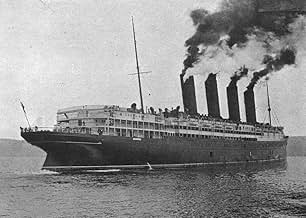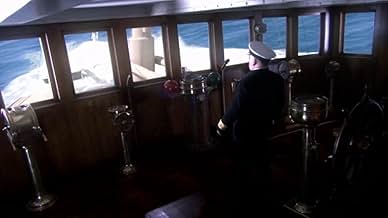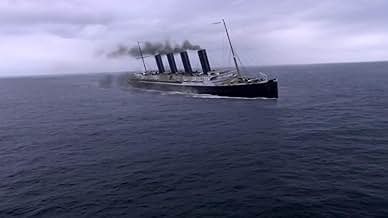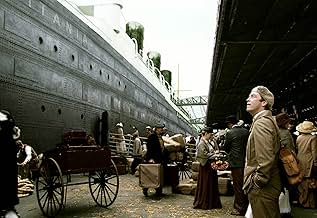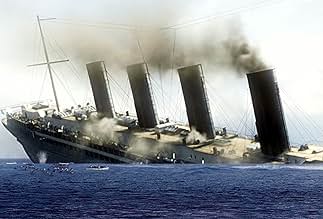अपनी भाषा में प्लॉट जोड़ेंA dramatization of the notorious World War I torpedoing of the ocean liner, RMS Lusitania.A dramatization of the notorious World War I torpedoing of the ocean liner, RMS Lusitania.A dramatization of the notorious World War I torpedoing of the ocean liner, RMS Lusitania.
Florian Panzner
- Lt. Capt. Schwieger
- (as Florian Panzer)
Madeleine Garrood
- Avis Dolphin
- (as Maddeleine Garrood)
Andre Weideman
- Johnston
- (as Andre Weiderman)
Stephen Jennings
- Carson
- (as Steven Jennings)
Robyn LeAnn Scott
- Peggy
- (as Robyn Scott)
कहानी
क्या आपको पता है
- ट्रिवियाThe U-20 set was the original U-96 set used in The Boat (1981). The Type U-19 of World War I and Type VIIC of World War II had similar internal dimensions.
- गूफ़On at least two occasions the captain of the U 20 gives the order to "blow ballast" when he wants to dive the submarine. This order would result in all water being blown out of the ballast tanks and should only be given to surface the boat. In order to dive a submarine one must flood the ballast tanks with water.
- भाव
Captain Turner: They're not interested in the truth.
- क्रेज़ी क्रेडिटAdrian Topol's character name is pronounced Voegele in the German dialogue and is spelled this way in the accompanying English subtitles. However in the credits it is spelled Vogele. Correct German spelling uses either "ö" (o with an umlaut) or else "oe".
- कनेक्शनFeatured in Titanic al detalle (2013)
फीचर्ड रिव्यू
Over a century ago, there was a time when warfare between nations was expected to be fought with some semblance of chivalry, and noncombatants were to be protected from harm.
Any semblance of that finally came to an end on 7 May, 1915.
Based on true events, this docudrama tells the story of one of the most pivotal events of the First World War, the sinking of the RMS Lusitania. This was the other British liner that went down tragically, but whose death could not have been more different. While not as lavish a production as the James Cameron movie, "Lusitania" nevertheless gives the viewer a reasonably accurate picture of the ship and its end. The performances are good, the story pretty much follows the historic record, and the special effects are convincing enough in depicting the death of the doomed liner. One of the movie's best scenes intersperses actual film footage of the Lusitania leaving New York on her final voyage, a sobering and haunting moment.
There's also an important backstory, namely the reason why the Lusitania was attacked in the first place. Both Lusitania and her sister Mauretania were listed as auxiliary cruisers in the Royal Navy registry. The ship was also loaded with munitions, in violation of international law. Through their agents in New York, the Germans were aware of this. There was also the fact that Winston Churchill, head of the Admiralty, wanted to create an incident at sea to bring America into the allied cause.
There are of course, some flaws in this production. For instance, the actor portraying Captain Turner in no way resembles the real person. The late Ian Holm would have been a better choice. However ,the main criticism of this motion picture is sometimes it gives the impression of being "Titanic" meets "Das Boot".
But when the torpedo strikes the hull and the contraband munitions explode, all similarities come to an end, and the mayhem that was the sinking is shown. People are drowned, pulled under, and meet other horrific ends. Unlike the Titanic, the band did not play on, the lovers did not unite, there was no nobility displayed by the passengers, and the Captain did not go down with the ship. This is where this film truly becomes the "Anti-Titanic". But even this cannot fully bring forth the nightmare that was the Lusitania. To make a comparison, the Titanic took two and a half hours to go under, while the Lusitania, a ship 90 percent the Titanic's size, went down in just 18 minutes. The percentage of loss of life was significantly higher, with 1200 souls lost out of 2000 aboard, including 120 Americans.
The international condemnation of Germany that followed this horrific loss of life was near unanimous. Like a prairie fire a wave of shock and indignation spread throughout America, and none other than former President Theodore Roosevelt declared the Lusitania's sinking to be a "barbarous act of piracy". President Woodrow Wilson however, decided to err on the side of caution. Nevertheless, the fuse was lit for America's eventual entry into World War I.
Any semblance of that finally came to an end on 7 May, 1915.
Based on true events, this docudrama tells the story of one of the most pivotal events of the First World War, the sinking of the RMS Lusitania. This was the other British liner that went down tragically, but whose death could not have been more different. While not as lavish a production as the James Cameron movie, "Lusitania" nevertheless gives the viewer a reasonably accurate picture of the ship and its end. The performances are good, the story pretty much follows the historic record, and the special effects are convincing enough in depicting the death of the doomed liner. One of the movie's best scenes intersperses actual film footage of the Lusitania leaving New York on her final voyage, a sobering and haunting moment.
There's also an important backstory, namely the reason why the Lusitania was attacked in the first place. Both Lusitania and her sister Mauretania were listed as auxiliary cruisers in the Royal Navy registry. The ship was also loaded with munitions, in violation of international law. Through their agents in New York, the Germans were aware of this. There was also the fact that Winston Churchill, head of the Admiralty, wanted to create an incident at sea to bring America into the allied cause.
There are of course, some flaws in this production. For instance, the actor portraying Captain Turner in no way resembles the real person. The late Ian Holm would have been a better choice. However ,the main criticism of this motion picture is sometimes it gives the impression of being "Titanic" meets "Das Boot".
But when the torpedo strikes the hull and the contraband munitions explode, all similarities come to an end, and the mayhem that was the sinking is shown. People are drowned, pulled under, and meet other horrific ends. Unlike the Titanic, the band did not play on, the lovers did not unite, there was no nobility displayed by the passengers, and the Captain did not go down with the ship. This is where this film truly becomes the "Anti-Titanic". But even this cannot fully bring forth the nightmare that was the Lusitania. To make a comparison, the Titanic took two and a half hours to go under, while the Lusitania, a ship 90 percent the Titanic's size, went down in just 18 minutes. The percentage of loss of life was significantly higher, with 1200 souls lost out of 2000 aboard, including 120 Americans.
The international condemnation of Germany that followed this horrific loss of life was near unanimous. Like a prairie fire a wave of shock and indignation spread throughout America, and none other than former President Theodore Roosevelt declared the Lusitania's sinking to be a "barbarous act of piracy". President Woodrow Wilson however, decided to err on the side of caution. Nevertheless, the fuse was lit for America's eventual entry into World War I.
टॉप पसंद
रेटिंग देने के लिए साइन-इन करें और वैयक्तिकृत सुझावों के लिए वॉचलिस्ट करें
विवरण
- रिलीज़ की तारीख़
- कंट्री ऑफ़ ओरिजिन
- भाषाएं
- इस रूप में भी जाना जाता है
- Sinking of the Lusitania: Terror at Sea
- उत्पादन कंपनियां
- IMDbPro पर और कंपनी क्रेडिट देखें
इस पेज में योगदान दें
किसी बदलाव का सुझाव दें या अनुपलब्ध कॉन्टेंट जोड़ें

टॉप गैप
By what name was Lusitania: Murder on the Atlantic (2007) officially released in India in English?
जवाब
